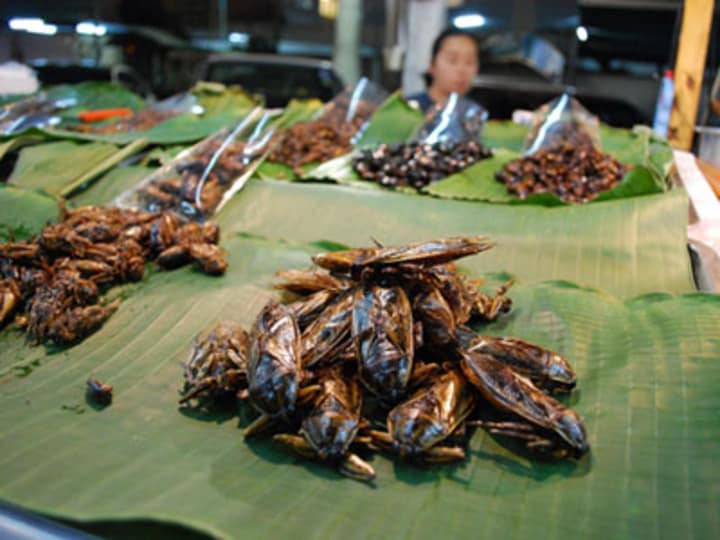
EDITOR’S NOTE: Developing a taste for “edible insects” may be the easiest way to meet world food needs and FAO is making a good case for eating bugs to truly go global, writes Stewart M. Patrick, senior fellow and Director of the International Institutions and Global Governance Program at the Council on Foreign Relations.
What world traveler hasn’t declined at least one local “delicacy?” A decade ago in Oaxaca, Mexico, I turned up my nose at chapulines, a steaming plate of toasted grasshoppers. “Tastes like chicken,” my waiter smiled unconvincingly. But overcoming disgust for “edible insects” may be the easiest way to meet global food needs, according to a fascinating, if occasionally stomach-churning, report from the UN’s Food and Agricultural Agency (FAO), based, of all places, in Rome.
The notion of meeting caloric, especially protein, needs from insects (as well as grubs, worms and other creepy-crawlies) is hardly new. It’s something humans and their hominid ancestors have been doing for millions of years. Paleoanthropologists and biologists speculate that our Paleolithic ancestors consumed prodigious quantities of insects—a fact conveniently omitted by most contempoary aficionados of the “cave man diet”. More recently, nineteenth century European arrivals to Australia marveled at aboriginal tribes’ insatiable appetite for insects, and the dramatic impact such a diet could have on their health and appearance, as documented in a fascinating ethnography, The Moth Hunters.
What’s surprising is how enduring the human taste for class Insecta remains. According to the FAO, more than two billion people—thirty percent of humanity—already supplement their diet with insects. And given the number of insects out there—1 million distinct species have already been identified and nearly two thousand proven edible—diners have a crunchy smorgasbord to choose from. “The most commonly eaten insect groups,” we learn, “are beetles, caterpillars, bees, wasps, ants, grasshoppers, locusts, crickets, cicadas, leaf and planthoppers, scale insects and true bugs, termites, dragonflies and flies.”
Most of today’s insect-eaters live in the developing world, in countries where insects are perceived as a perfectly acceptable and convenient source of energy—readily (or at least seasonably) available, highly portable, and requiring fewer inputs than agriculture or animal husbandry. In terms of nutrition, insects provide an outstanding advantages, having ”high fat, protein, fiber, vitamin, and mineral content,” and can be a particularly important diet component for children under the age of five in poor countries.
While many in the West may recoil in disgust, the FAO makes a compelling case on food security grounds for entomophagy (eating bugs, in science-speak). Often dismissed as “famine foods,” insects may offer at least part of the answer to the global food crisis. And a crisis is what we have on our hands. Based on current demographic and dietary trends, as I’ve written before, the world needs to double its food production over the next forty years—an effort that will require unprecedented productivity gains while risking ecological calamity.
Here’s where insects come in. Insects, it turns out, are far more efficient than livestock — perhaps ten times so — in transforming feed into edible meat. And they largely avoid the huge greenhouse gas emissions, as well as other environmental pollutants, associated with livestock. While most edible insects continue to be collected in the wild, more organized forms of insect farming have emerged, including “cricket farming” in Laos, Thailand, and Vietnam. Insects are also being increasingly used as animal feed, particularly for poultry and acquaculture. By providing employment opportunities, the edible insect sector has a potential role to play in rural development, from Southeast Asia to Central Africa.
To have a real impact on food consumption patterns, however, edible insects must go global. Today, the international trade in these commodities is neglible, limited to niche markets like fulfilling the dietary desires of diaspora populations.
Expanding global trade in edible insects will require expanding existing national and multilateral health and sanitary regulations. This will include updating the Codex Alimentarius, created by FAO and the World Health Organization in 1963 to harmonize international food standards and codes of practice.
The biggest stumbling block to expanding global consumption of insects is cultural. The very idea of eating bugs remains taboo in many countries, particularly in the wealthy West, where they tend to be confined to “novelty snacks.” There may be ways to make inroads against this stigma, however. A few celebrity U.S. chefs have put insect items on their restaurant menus. In the future, one could imagine trend-setters like Anthony Bordain competing with counterparts to see who can make the tastiest dragonfly confit. Who knows? With Manhattan and L.A. foodies leading the charge, would Middle America be far behind?
So, if you’re inclined to strike a blow for global food security, or just want to set the trend in your hometown, you’re in luck. Since 2010, the FAO has created a useful ”Webportal of Edible Insects,” listing your culinary options. Be sure to check out the chapulines. I hear they taste like chicken.
Edited for style and republished with permission from theCouncil on Foreign Relations. Read the originial article.
